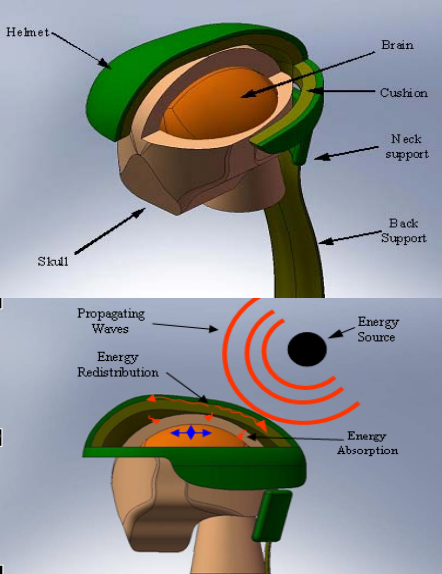![]() Mild Traumatic Brain Injury - Helmet Material
Mild Traumatic Brain Injury - Helmet Material
PI: Prof. Bala Balachandran
The Mild Traumatic Brain Injury (MTBI) Committee of the Head Injury Interdisciplinary Special Interest Group of the American Congress of Rehabilitation Medicine has defined MTBI as traumatically induced physiological disruption of brain function manifested by at least one of the following: i) any period of loss of consciousness; ii) any loss of memory for events immediately before or after the accident; iii) any alteration in mental state at the time of the accident. We have formed a group consisting of engineers and scientists from the CECD, the ETC, and the Medical School in Baltimore to study this with the view of redesigning helmets that would mitigate the effects on the brain.
State of the Art
Pellman et al. (2006) investigated the performance
of new NFL helmets under impact. It was shown
that newer design improved the absorption of
impact energy during normal conditions in a
football match. However, better designs are still
needed to overcome what is called the elite impact
condition, normally at speeds above 11.2 m/s.
Sensors have been implemented to measure real
time impacts during college football matches. The
collected data may help understand when
concussions occur. Accelerometers have been
used as sensors in these studies.
Continuing Studies
Our group is studying these issues in an effort to
address gaps and questions, which include the
following:
• Standard criteria used for establishing injury
criteria consider only the motion of the
center of mass of the head. Injury criteria are
formulated as empirical relationships that
depend on the acceleration of the head.
While there is much discussion about the
relative importance of linear acceleration
versus angular acceleration in causing a
brain injury, the approach suffers from the
fundamental shortcoming that the relative
motion of the brain with respect to the skull
is not taken into account. Furthermore,
despite the brain being a highly deformable
entity, brain deformations are not taken into
account in the models.
• While finite element models point to coup
pressure and shear strain as failure criteria
and also show that the use of helmets
reduces the pressure and shear stress on the
skull elements, they offer little insight into
the actual mechanism of energy transfer to
the brain as a result of impacts on the skull.
• A system approach could be useful in
formulating the problem.
• Recent experimental work based on MRI
methods has provided in vivo strain
measurements on the brain. These results
point to the importance of developing injury
criteria that are based on brain deformation.
Helmets could be designed as energy
absorbing and redistributing mechanisms in
the energy path to the brain (see figure).
• Perhaps a helmet with a harness should be
considered to reduce the translational
acceleration levels experienced by the brain
(see figure).


